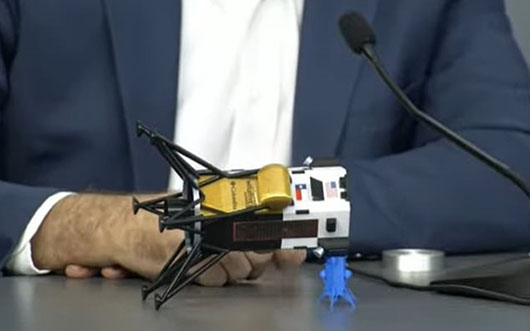FPI / March 1, 2024
By Richard Fisher
The second United States attempt to send an unmanned Moon Lander to the Moon apparently will end in mission termination on Feb. 27, while China on Feb. 23 revealed new information and projected confidence in its ability to send astronauts to the Moon before 2030.

All of this is important because the United States has already delayed its manned return to the Moon from 2025 until 2026, a schedule that it may not be able to hold, while China systematically prepares to build its International Lunar Research Station to obtain political, resource and geostrategic advantage.
On Feb. 23, the planned Moon landing date of the Astrobotic Company’s Peregrine-1 unmanned Moon Lander, the United States was supposed to have two unmanned Moon Landers on the Moon, but by Jan. 9, the Peregrine-1 was declared incapable of completing its landing mission due to a fuel leak.
Then on Feb. 27, the IM-1 Nova-C Moon Lander “Odysseus” of the Intuitive Machines Company, was forced to terminate its mission after its Feb. 22 Moon landing resulted in the lander falling to its side, preventing solar panels from gathering needed power for the lander.
While the Odysseus lander had to make an emergency last-minute landing radar substitute in order to reach the surface of the Moon, its did gain brief fame on Feb. 22 as the first United States space craft — and the first privately owned craft — to land on the Moon in 52 years following the 1972 manned Apollo-11 mission.
Then Houston-based Intuitive Machines CEO Steve Altemus explained in a Feb. 23 press conference that the Nova-C Moon Lander made a hard landing and caught one of its six landing legs on the Moon surface, resulting the lander falling to its side.
This resulted in Odysseus not being able to perform its primary mission, to drill for Moon samples and then to analyze them to confirm the presence of lunar ice water.
In the landing drama it was also unable to deploy its Eagle Cam cameras built by Emery Riddle University to image the $118 million lander and due to the lander’s solar panels’ inability to gather solar energy, by Feb. 27 Odysseus was expected to turn off.
The second of several private sector unmanned Moon probes funded by the Commercial Lunar Payload Service (CLPS) program funded by the National Aeronautics and Space Administration (NASA), Intuitive Machines may get a second chance should it launch its IM-2 lander before the end of 2024.
Full Report . . . . Current Edition . . . . Subscription Information
Free Press International
